Luxury Washable Merino Wool Knitted Baby blanket
Merino wool is a natural fiber grown year-round by Merino sheep, consuming a simple blend of natural ingredients including sunshine, water, fresh air and grass. Every year these sheep produce new fleece, making wool a completely renewable fiber.
Arguably the oldest-known animal fiber, wool is composed of a natural protein called keratin - the same protein found in human hair - with a small amount of calcium, sodium and fat. The surface of each fiber is covered in scales, which are important in making felts and traditional woollen cloths.
Why we use wool?
It's cool when it's hot, and warm when it's not!
Wool is a natural insulator to keep you warm in winter and naturally breathable to keep you cool in summer.
Wool fiber helps to keep your body at the optimal temperature zone for comfort and rest. When used in blankets, synthetic fibers, down and even cotton fibers do not breathe as well as wool and are more likely to trap heat in your bed. Wool buffers the extreme cold or hot air on the outside, keeping your body in the ideal comfort zone. Baa-brilliant!
It's naturally absorbent!
Wool fiber is the original wicking fiber. Wool fabrics can absorb up to 30% of their weight without feeling heavy or damp. Cotton fabrics begin to feel damp after 15%. The fibres 'breathe' by absorbing away moisture from the body and releasing it into the air.
This quality makes wool fabrics comfortable to wear in warm and cold weather.
It resists Mildew and Mold, naturally!
Wool's natural resistance to mildews and moulds comes from the way it repels moisture, and lets moisture pass through it's fibers without trapping it. Mildews and moulds require moisture to live, and grow.
It's durable!
Laboratory tests have shown that wool fibres resist tearing and can bend back on themselves more than 20,000 times without breaking. Cotton breaks after 3,200 bends, silk fibres break after 1,800 bends, and rayon fibres break after just 75 bends. Wool clothing will last for years.
Wool also resists spills and dries very quickly.
It's naturally wrinkle resistant!
Wool fabrics resist wrinkles. Wool is the most resilient fibre because it has a natural crimp that helps it keep its shape. Wool fibres can be stretched and still bounce back to their original shape.
Wool is safer to wear because of its natural fire-retardant properties. It can resist flame without the chemical treatment
involved in fireproofing. Most synthetic fibres ignite easily, burn fiercely and melt at an alarming rate.
It's clean!
Wool resists static, dirt and dust. Wool fabric doesn't collect much static because of its absorbent fibres. Static attracts lint,dirt, and dust. Wool fabrics also clean easily because dirt sits on the surface of the fibre. The outside surface of the wool fibre consists of a series of overlapping scales, similar to the feathers on a bird, making it easy to brush off and for stains to lift out.
It's hypoallergenic!
Wool is hypoallergenic. Although some people do have a rare natural allergy to Lanolin, the oil found in wool, most people's
allergy to wool is a reaction to the many harsh and toxic chemicals that go into the treatment, and finishing of conventional wool garments and bedding. Serious chemical abrasives are routinely used to wash raw wool for processing. Chlorine and mothproofing chemicals are routinely applied to conventional wool before turning it into a finished product.
It's renewable and sustainable!
Wool is a renewable resource that can be shorn from sheep annually. It is biodegradable and kinder to the environment than oil-based synthetics, which contribute to global pollution.
What are different types of wool?
Not all wool is the same. Some wool is softer than cashmere, while others are hardier and more resilient, suitable for carpets and bedding. Wool can be divided into three main categories, based on the micron (diameter) of each fibre. One micron is equal to one millionth of a metre and fibre length is recorded in millimetres – these are the main measurements which determine the quality and use of the wool.
* Fine: Wool with the finest micron comes from Merino sheep and is used for high-quality, soft-handling fabrics and knitting yarns. Fine wool is highly valued by the world’s leading fashion houses and is the hero ingredient of many Woolmark collaborations.
* Medium: Medium micron wool can be produced from a type of Merino or produced by crossing one breed with another
(crossbreeding). Medium wools are used in a variety of woven apparel cloths, knitting yarns and furnishings.
* Broad: Many different sheep breeds produce broader wools. Often these breeds are known as dual-purpose breeds because they are farmed with equal emphasis on meat and wool. Broad wool is useful for products such as carpets because of its strength and durability
The average micron of human hair is between 50 to 100 micron. Merino wool is generally less than 22 micron, which shows just how oft this premium fibre is.
What are natural fibres?
Natural fibers are fibers that are made out of natural materials that come from plants, animals, or minerals. The raw, natural materials are spun into threads and yarns that are then woven or knit into natural fabrics. There are two general categories of natural fibers: animal-based or plant-based. Animal-based natural fibers include silk, wool, alpaca, cashmere, while plant-based natural fibers include cotton, linen, and jute.
What are advantages of Using Natural Fibres?
Natural fibers are popular for many different reasons, as the fabric is generally more environmentally friendly and durable.
* Absorbent. Natural fibers have an incredibly high absorbency, as the fibers, both plant and animal, have a strong affinity for water. This makes natural fibers a great option for bed sheets and towels, as absorbency is an important factor for these items because they’re used to dry surfaces and receive regular use.
* Eco-friendly. Natural fibers usually have a smaller environmental impact than synthetic fibers because natural fibers do not use as many chemicals during the production process. Some natural fibers are less eco-friendly than others because some plants require more water.
* Durable. Due to the structure of cellulose, which makes up natural materials,, most plant-based fibers are very strong.
Animal-based fibers, like silk and wool, are also strong.
What are synthetic fibres?
Synthetic fibers are made of synthetic materials, usually derived from fossil-fuelled/petroleum-based oils. The fibres are
generally extracted during the chemical process using a spinneret, which is a device that takes polymers to form fibers. The textile industry began creating synthetic fibers as cheaper and more easily mass-produced alternatives to natural fibers.








